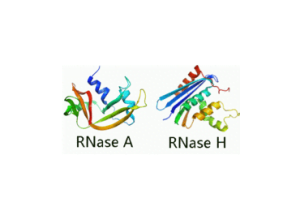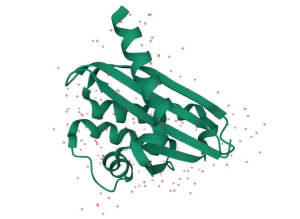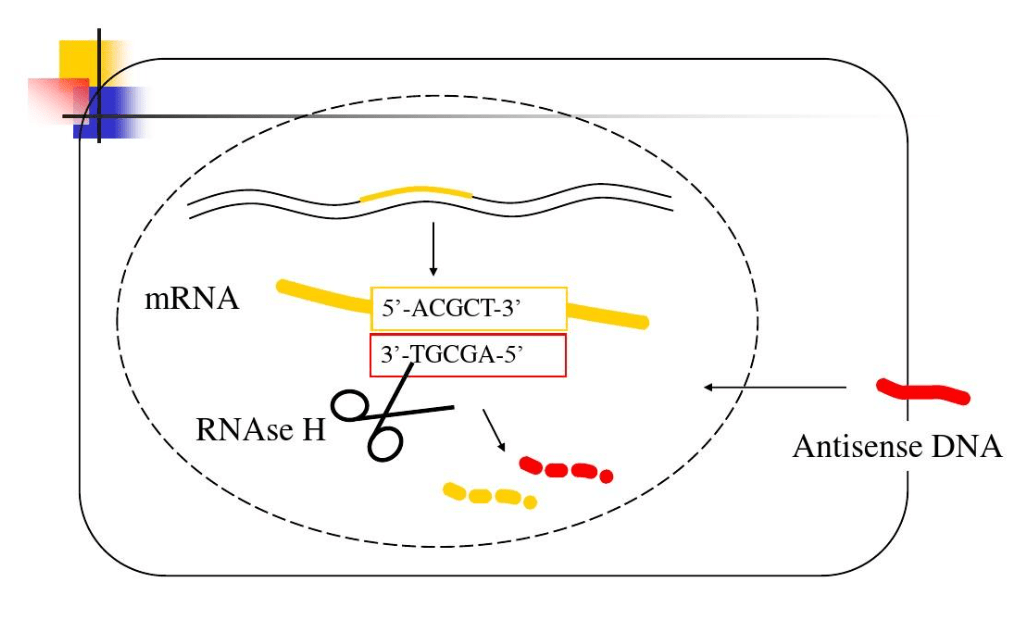Ribonuclease H, or RNase H for short, is an endoribonuclease enzyme with the puzzling ability to specifically hydrolyze the phosphodiester bonds of an RNA strand that is hybridized to DNA. Though its activity seems paradoxical, RNase H plays a crucial role in fundamental cellular processes by selectively targeting RNA portions in RNA-DNA hybrids. The bursty nature of its site-specific cleavage abilities makes it a versatile tool in molecular biology techniques.
Here we will explore in depth what RNase H does, how it works, the key features and applications of the recombinant RNase H product from NEB, and help researchers choose the right RNase H enzyme for their needs.

What is the Function of RNase H?
The primary function of RNase H is to cleave the RNA strand of RNA-DNA duplexes, leaving the DNA strand intact. This targeted RNA digestion helps resolve RNA-DNA hybrid intersections that can form during DNA and RNA transactions inside cells. RNase H activity is crucial for various DNA and RNA metabolic processes like DNA replication, transcription, and Okazaki fragment maturation.
It prevents RNA primers from persisting in DNA and removes RNA transcripts hybridized to complementary DNA templates. This process of targeting and breaking down the RNA portion specifically while protecting the DNA portion is central to the role RNase H plays in facilitating nucleic acid transactions in vivo.
How Does RNase H Work and What is Its Enzymatic Activity?
RNase H works by locating RNA-DNA hybrid regions and then precisely cleaving the phosphodiester bonds between the 3′-hydroxyl group of the RNA ribose and the phosphate group of the next RNA ribose in the chain. It catalyzes an acid-base hydrolysis reaction without disturbing the integrity of the DNA strand.
At the molecular level, RNase H recognizes the RNA-DNA junctions and binds strongly to the duplex structure. Its active site then clips the phosphodiester bonds of the RNA strand one by one proceeding in the 3′ to 5′ direction. This process continues till the entire RNA segment is degraded without affecting the DNA partner. This targeted enzymatic activity is referred to as RNase H activity and is quantified as the amount of RNase H required to cleave a specific amount of RNA in an RNA-DNA hybrid within a given period under defined conditions.
What Are the Key Features and Applications of NEB’s RNase H Product?
New England Biolabs or NEB is a leading provider of high-quality enzymes for molecular biology applications. Their recombinant RNase H is a refined enzyme with several advantageous features. It is supplied along with an optimized reaction buffer to support its activity over a wide pH and temperature range. As a recombinant product, it offers consistency between batches without contaminants.
NEB’s RNase H shows high RNase H function and specificity, digesting the RNA strand with neb RNase H of an RNA-DNA hybrid selectively without disturbing DNA. It has applications in techniques like reverse transcription PCR (RT-PCR) where it helps resolve RNA-cDNA hybrids formed during first-strand synthesis by RNase H activity. NEB’s thermostable RNase H is also available for higher-temperature nucleic acid applications.
What Conditions and Buffers Are Required for Optimal RNase H Activity?
For optimal RNase H activity, NEB’s recombinant RNase H requires specific reaction conditions and buffer components. The supplied 10X RNase H reaction buffer consists of Tris-HCl, KCl, MgCl2, and DTT to maintain the correct ionic strength and pH for maximal enzymatic function. RNase H works best at pH 8.3 and 37°C. The inclusion of Mg2+ ions in the buffer is important as the RNase H function depends on Mg2+ for its catalytic activity.
DTT acts as a reducing agent to protect the enzyme from oxidation. Reactions are set up by combining the RNase H enzyme, substrate RNA-DNA hybrid and buffer at a 1X concentration. Proper buffering enhances RNase H stability and consistent cleavage of the RNA moiety from hybrids.
What Types of Nucleic Acids Does RNase H Act-On and Not Act-On?
Although RNase H selectively targets RNA in RNA-DNA duplexes, it does not digest single-stranded RNA or DNA. Neither does it cleave double-stranded DNA. Its precise enzymatic RNase H activity is particular for RNA hybridized to the DNA strand. The enzyme efficiently identifies and degrades the RNA portion of an RNA-DNA heteroduplex without disturbing the integrity and continuity of the DNA partner.
RNase H exhibits little to no activity on singular nucleic acid strands or on double-stranded DNA molecules which lack an RNA-DNA junction. This stringent substrate specificity enables controlled and targeted RNA removal from hybrid complexes essential for various nucleic acid transactions.
What Is the Source and Production Method for NEB’s Recombinant RNase H?
NEB’s RNase H is recombinantly produced in E.coli for high purity and consistency between batches. The cloning source is the native RNase H gene isolated from Escherichia coli which codes for the endogenous RNase H present in E.coli cells. This gene is inserted into an expression vector and amplified in a non-pathogenic E.coli strain. Induction of the vector leads to high-level recombinant RNase H protein expression.
The overexpressed RNase H is then purified using column chromatography to obtain a highly purified preparation free of contaminating nucleases. Quality control checks certify the recombinant enzyme exhibits authentic RNase H activity and specificity. The final product is supplied along with a reaction buffer optimized for its function.
How Is NEB’s RNase H Used in Molecular Biology Techniques Like RT-PCR?
One important application of RNase H is in reverse transcription PCR (RT-PCR) where it helps resolve RNA-cDNA hybrids formed during first-strand síntesis de ADNc. In RT-PCR, an RNA template is first reverse-transcribed to its complementary DNA (ADNc) using a DNA primer. This process results in RNA-cDNA hybrid duplexes. NEB’s recombinant RNase H is then used to selectively degrade the RNA strand of these hybrids leaving only single-stranded cDNA.
Degrading the original RNA template prevents it from interfering with subsequent PCR amplification. By cleaving the RNA effectively, RNase H enables exponential amplification of only the cDNA to detect and analyze specific RNA transcripts. Its precision and efficiency in degrading hybridized RNA under optimized conditions enhance the quality and sensitivity of RT-PCR analysis.
What Are the Temperature Ranges and Heat Inactivation Points for NEB’s RNase H?
Regular RNase H from NEB is active between 25-42°C with maximal activity around 37°C. It gets irreversibly inactivated upon heating to 65°C for 20 minutos. For applications requiring higher temperatures, NEB also offers a thermostable variant of RNase H. This heat-resistant RNase H is fully functional between 25-80°C with increasing activity at elevated temperatures up to 50-60°C.
It remains stable even after heating to 80°C, making it suitable for demanding nucleic acid techniques run at higher thermal cycling conditions. Thermostable RNase H can withstand heat inactivation steps and proteinase K treatment, offering more flexibility. Both RNase H versions are supplied along with extensive product documentation for effective use.
How to Choose Between Regular and Thermostable RNase H from NEB?
The choice between regular and thermostable RNase H depends on the temperature requirements and workflow. Regular RNase H is a cost-effective option if reactions can be performed below 42°C, as in standard RT-PCR. Thermostable RNase H offers advantages for techniques involving elevated heat cycles from 50-80°C like nested PCR, reverse transcription loop-mediated isothermal amplification (RT-LAMP), and other thermal profiling applications. Its heat-resistant properties prevent its activity loss during multiple heating steps.
Researchers performing high-temperature nucleic acid analysis benefit from thermostable RNase H’s extended functional range and durability. Overall, NEB’s recombinant RNase H enzymes provide reliable tools for controlled RNA digestion in RNA-DNA complexes across a wide range of uses.

Resumen
En conclusión, this blog post aimed to comprehensively explain what RNase H is, how it specifically functions, the key attributes of NEB’s recombinant RNase H products, optimal reaction conditions, applications in techniques like RT-PCR, and considerations for choosing the right RNase H enzyme.
By delving into its intriguing enzymatic activity and targeted RNA cleavage abilities in a simple yet detailed manner, I hope this helps shed more light on the versatile RNase H and its important role in nucleic acid transactions. Please let me know if any other aspect needs more clarification.
